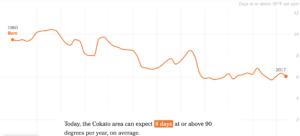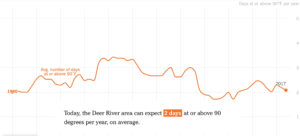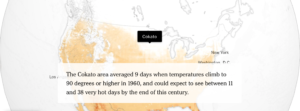New York Times Climate Model Shows Minnesota Has Cooled
“How much hotter is your hometown than when you were born?” That’s the inflammatory headline of the New York Times interactive tool designed to demonstrate on a personal level that cataclysmic global warming has already hit home.
As the world warms because of human-induced climate change, most of us can expect to see more days when temperatures hit 90 degrees Fahrenheit (32 degrees Celsius) or higher. See how your hometown has changed so far and how much hotter it may get.
I discovered it on the Facebook page of the Minnesota Pollution Control Agency, which leads the state’s Interagency Climate Adaptation Team and efforts to reduce Minnesota’s culpability in the climate’s demise. Minnesota regulators were only too happy to help hype the gimmick.
Is your hometown hotter than it was when you were born? This interactive graphic will tell you, and also how much warmer it is expected to get in the near future as a result of climate change.
The assumption? No matter how “hot” you thought your hometown was back in the day, it’s hotter now. But did anyone at MPCA take time to run the numbers? The results in my case make me wonder.
When I plugged my age and hometown of Cokato, Minnesota into the climate calculator, the numbers on the screen brought back idyllic summer days in our swimming hole at Brooks Lake.

Braced for the worst, I fast forwarded to 2018. To my surprise the results were nothing short of reassuring, unless you’re a climate alarmist. The Times’ tool shows my hometown has cooled off significantly in the last half century as measured in 90 degree days.
Cokato went from nine 90 degree or higher days in 1960 to six today, a decline of 33 percent. Perhaps that 1970’s media speculation about global cooling wasn’t so far off the mark after all!

The same holds true for Minneapolis, which recorded seven days of 90 degree heat in 1960, compared to six today. Happily, our longtime family cabin in the Deer River area also appears to be in the clear, logging the same number of 90 degree days now as in the “Leave It to Beaver” era.

But it’s not all good news. The nearly 60 year overall cooling trend won’t last forever, according to the paper’s climate calculus. By the end of the century, it seems the old hometown could be on the brink with a spike to anywhere from 11 to 38 days of 90 degree or warmer weather, give or take.

Unfortunately, there doesn’t appear to be much the world can do about it either.
The Cokato area is likely to feel this extra heat even if countries take action to lower their greenhouse gas emissions by the end of the century, according to an analysis conducted for the New York Times by the Climate Impact Lab.
Yet a closer look at the paper’s methodology reveals a curious disclaimer. Could the Times be cherry-picking data?
We do not include locations with fewer than three 90-degree days per year on average throughout the entire time period, or for selected other regions where day-to-day variation in maximum temperature is underestimated by the model.
Take San Leandro, California, where one of American Experiment’s staff members grew up. It’s excluded from the paper’s data base, evidently because it’s too cool, thanks to the Bay breeze that generally keeps temperatures under 90.

Overall, Minnesota fares better than most states when it comes to speculation over global warming, even by the Times’ calculations. What are the implications for state climate policy that generally assumes the worst?